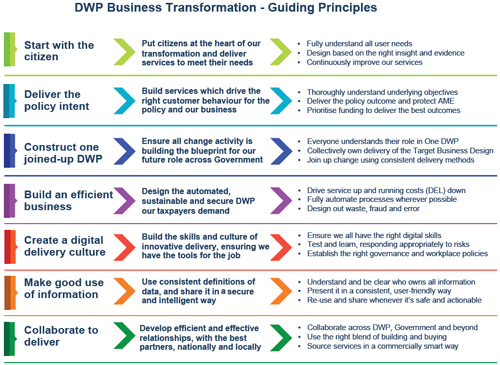
About a year ago DWP established a set of Guiding Principles to drive our business transformation. More recently, we shared our vision of how DWP will operate in 2020. We are now working through the details and putting some of the building blocks in place. I'm Richard Barton in the Business Design team in DWP and I'm reflecting on the impact that digital technology will have on DWP’s products and services.
From internet engagement to digital delivery
No doubt you will be aware that the modern way to serve customers and citizens is 'digital'. If you believe many of the articles written about the subject, digital seems to involve delivering applications on smart watches, attracting 'Likes' on Facebook and dealing with complaints on Twitter. Fortunes are about to be won and lost on the back of this transformation whilst, in the executive suite, arguments rage between Marketing, IT and the new, all-powerful, Chief Digital Officer (CDO). These articles may be entertaining but they don't reflect reality.
Clearly, digital technologies do help to make all sorts of customer-facing interactions more flexible and useful. Why wait in a high street store or a telephone queueing system to talk to someone when you can raise your request or get answers to your questions whenever you want and wherever you happen to be? In addition, smart organisations are cleverly structuring their customer communications to uncover new information and improve their services. However, as Matthew Hancock explained recently, real transformation comes through using digital foundations to deliver goods and services.
Digital delivery
Digital delivery started in industries which were already information rich, such as Financial Services. After all, a business which can deliver by changing the balance of an account does not have to undergo a great deal of change to become digital. Entertainment, including music and television, has been on a digital transformation journey since compact discs (CDs) and NICAM broadcasts became common 25 years ago.
What is really exciting now is the way that other products are becoming infused with information or being enhanced with information - creating new candidates for digital disruption. Currently, Tesla Motors and Uber provide differing, but equally high-profile, examples of how information can enrich transport. There is a lot of interest in exposing and exploiting the information hidden away in the operations of the energy sector. Less attention is going into things like food at the moment but there are already signs of what may come later - fancy a bite of my 3D-printed, personalised chocolates?
The common factor in all of these examples is a shift of focus from the tangible to the intangible creating opportunities which can be unlocked with digital technology.
This shift has already started for our public services. Our understanding of health and wellbeing used to be dominated by the physical aspects - think of surgery and mass-produced pharmaceuticals. Our attention is now being drawn to personal lifestyle choices (and even more personally to our unique DNA). Opportunities are also being created in welfare as the focus shifts from top-down, centralised provision to an approach based on empowering people to make well informed choices for themselves. The shift is uncovering useful information which was previously hidden and giving us ways to enrich welfare services with new information.
Benefits at internet speed
At DWP, we are already using these opportunities. Tailoring services to people's needs can produce better outcomes and we can save time and money through automation. As an example, we use Real-Time Information about earnings collected by HMRC to make adjustments to benefits payments. This makes it easier for people, avoids a heap of administrative work from our busy staff, eliminates costly mistakes and reduces the opportunity for benefit fraud.
There is still plenty of work to be done to deal with some complex legacy systems and we also need to build new tools and develop new ways of working. This work is not always as glamorous and high-profile as launching a new digital service but it is just as demanding, exciting and important. The results will be public services which are more satisfying and better value for everyone - taxpayers, our customers and delivery teams.


